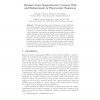Free Online Productivity Tools
i2Speak
i2Symbol
i2OCR
iTex2Img
iWeb2Print
iWeb2Shot
i2Type
iPdf2Split
iPdf2Merge
i2Bopomofo
i2Arabic
i2Style
i2Image
i2PDF
iLatex2Rtf
Sci2ools
MICCAI
2009
Springer
2009
Springer
Dynamic Layer Separation for Coronary DSA and Enhancement in Fluoroscopic Sequences
Abstract. This paper presents a new technique of coronary digital subtraction angiography which separates layers of moving background structures from dynamic fluoroscopic sequences of the heart and obtains moving layers of coronary arteries. A Bayeisan framework combines dense motion estimation, uncertainty propagation and statistical fusion to achieve reliable background layer estimation and motion compensation for coronary sequences. Encouraging results have been achieved on clinically acquired coronary sequences, where the proposed method considerably improves the visibility and perceptibility of coronary arteries undergoing breathing and cardiac movements. Perceptibility improvement is significant especially for very thin vessels. Clinical benefit is expected in the context of obese patients and deep angulation, as well as in the reduction of contrast dose in normal size patients.
Coronary Arteries | Coronary Digital Subtraction | Coronary Sequences | Medical Imaging | MICCAI 2009 |
| Added | 06 Nov 2009 |
| Updated | 15 Nov 2009 |
| Type | Conference |
| Year | 2009 |
| Where | MICCAI |
| Authors | Ying Zhu, Simone Prummer, Peng Wang, Terrence Chen, Dorin Comaniciu, Martin Ostermeier |
Comments (0)

